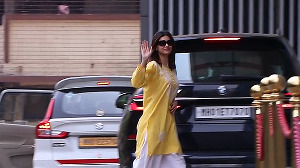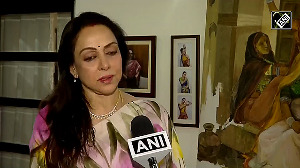The cupid struck long before Valentine's Day. In end-September 2005, luggage maker VIP was glowing. It was not just the new-found love, but also a new logo and a fresh range of offerings that explained the glow.
Old tricks to sustain customer interest? Yes, but with a twist. For the first time in 34 years of its existence, the company has introduced a range of luggage that boldly claims for ladies only.
The new range, with three strollys (suitcases with attached trolleys), two duffel strollys (cylindrical bags with trolleys), a duffel bag and a beauty case come in two colours black and onion pink.
But is this a case of old trapeze artists wearing fresh lipstick?
Sunil Kataria, vice president, marketing, Blow Plast (the marketing arm of VIP Industries), claims otherwise. He says, "This is the first time any company in the luggage sector is specifically targeting the Indian women."
That's partially true. In 2001, Samsonite, the international luggage brand had introduced luggage for women. But it failed to cut ice in the Indian market. Executives at VIP claim that it was possibly because the range did not specifically target the Indian women.
VIP believes that its attempt will have a different ending. That is because its decision to introduce a range for women is backed by research. In February 2005, market research agencies, Quantum and Indian Market Research Bureau conducted a study across eight Indian cities.
When the study was completed in nearly six months, it revealed that VIP had a strong emotional connect with customers. But there was a definite need for new and innovative luggage.
For instance, women had a suitcase-ful of woes. Sarees always got crushed when packed in suitcases. It was embarrassing for women when their essentials like inner wear and personal hygiene products were thrown into the open during security checks. Then, clothes got spoilt if medicines or cosmetic bottles leaked inside the suitcase.
Based on the findings, VIP Industries decided to focus on gender-definitive products. The company introduced features such as a saree holder (a separate compartment to hang sarees), a detachable spill-proof medicine and cosmetic kit (to protect clothes) and an essentials bag (a pocket at the bottom to store personal hygiene products and inner wear).
But just launching new features in an existing product would hardly create the desired impact. And a lot was at stake, especially when the company had earmarked close to Rs 20 lakh on research and development.
Hence, it decided to concentrate on the weight factor of suitcases women do not prefer carrying suitcases when they are travelling alone. It is difficult to offload it from a conveyor in the airport, or load it on a rack.
If the company has taken kilos off the suitcase, it's putting all its weight behind advertising. It's spending Rs 6 crore on advertising in the current quarter, and has earmarked a total budget of Rs 20 crore for the fiscal.
The company is launching a print campaign aimed entirely at women. For its television campaign, the company plans to target specific television channels that enjoy a high percentage of women viewership.
The company is not content with this. VIP Industries is opening 41 more company-owned retail outlets to deliver a consistent look-and-feel to its customers. This takes the total number of company-owned stores to 110.
If industry experts are to be believed, targeting women in the age group of 21-35 years with an exclusive range could help in more ways than one. By making luggage that targets women, it will help the cause of making luggage fashion centric an element the industry has been trying to bring in for a long time.
Why fashion in luggage? Ramesh Tainwala President, Samsonite, South Asia, explains that travellers see what they carry as a reflection of their attitude so they have to be fashionable. Then, if products are fashion-specific, the lifecycle of the product will come down drastically.
That's what luggage makers are praying for. Because, Indian customers clutch on their luggage forever when VIP had launched an exchange scheme three years ago, it discovered that customers came with suitcases that had cracked right in the middle!
If women are made conscious about the luggage they carry, they will change it, or even add to their collection more frequently. Maybe the company also hopes that the trend will rub-off on the entire family.
Hence, it is looking at segmenting the market further by launching an exclusive range for men, a collection for the youth and so on. Kataria claims that VIP Industries is trying to reposition itself to cater to the aspirations of the growing global mindset of the Indian consumer. Incidentally, rival Samsonite has also been playing the same tune of catering to global Indians.
But this upmarket audience makes less than 50 per cent of the Indian market for luggage. According to industry estimates, the luggage industry is worth Rs 1,400 crore. But Rs 800 crore is cornered by the unorganised sector, which makes a killing by selling luggage at a fraction of VIP's or Samsonite's cost.
For VIP Industries, which is the largest player in the organised sector with a market share of 60 percent, this is bad news. That's because at an average of Rs 5,000 (cost of the large size Aura), the cost of a VIP suitcase becomes 10 times as that of a Chinese product. But Samsonite and VIP dismiss Chinese products.
The reason: in luggage, durability is an important factor for Indians, which Chinese products fail to deliver. But if introducing fashion is going to make product lifecycles shorter, then could Chinese designs also be a threat? Kataria claims that customers who dispose products that are 'out of fashion' swear by brands.
They would not be caught dead carrying unbranded luggage. He adds that while lower- and middle-income group customers look for durability, the top-end customers look for well-designed stylish products. The Chinese according to him, have neither. The only question is will women buy this? Both the argument and the product.
On a deserted highway, a lady is arguing with her partner. Tempers rise to a boil. The furious lady demands that the car should be stopped. But she does not walk out alone. She also walks off with the other love of her life her suitcase.
This is luggage maker VIP's television commercial for its women's range, Aura. Sunil Kataria, vice president, marketing, Blow Plast (the marketing arm of VIP), says, "Women are independent thinkers and are no longer afraid (like taking off on their own in a deserted highway)."
He adds, "The ad signifies the independence of thought and action that women enjoy at present."
The current commercial is a part of a campaign that has six new commercials, all of which revolve around the different range of products.
The campaign is also a part of a continuing attempt by the company to deliver a younger look-and-feel. For the past two years, the company has been consistently trying to target a young audience (21-35 years) with the "bye, bye, bye, bye..." jingle that closely resembles the Sound of Music hit, So long, farewell.
Ironically, with that campaign VIP has also been bidding farewell to its memorable jingle that illustrated sad moments of departure: remember the emotional overtones of the powerful VIP campaign, Kal bhi, aaj bhi..., in the early 1990s?
The Kal bhi, aaj bhi... campaign created a strong emotional bond with customers, but it also took VIP closer to an older set of customers who believed in value-pricing, durability of products and so on. After the late 1990s, however, VIP disappeared from TV screens. When it reappeared in 2003, the melancholic nostalgia was missing.
Company executives, however, claim that they can't ditch the emotional appeal completely. Hence, they have shifted from a purely emotional connect to an emotional peg that's supported by a rationale.
"The new ads also project the thoughtful features of the product," says Kataria. For instance, a kid pulling a strolly is showcased to demonstrate ease of use.
Besides, the company says that it wants to associate itself with happiness as it reflects the current mood of the nation.
"In the earlier decades, we were struggling and Kal bhi aaj bhi captured that thought to perfection," says Kataria.







 © 2025
© 2025